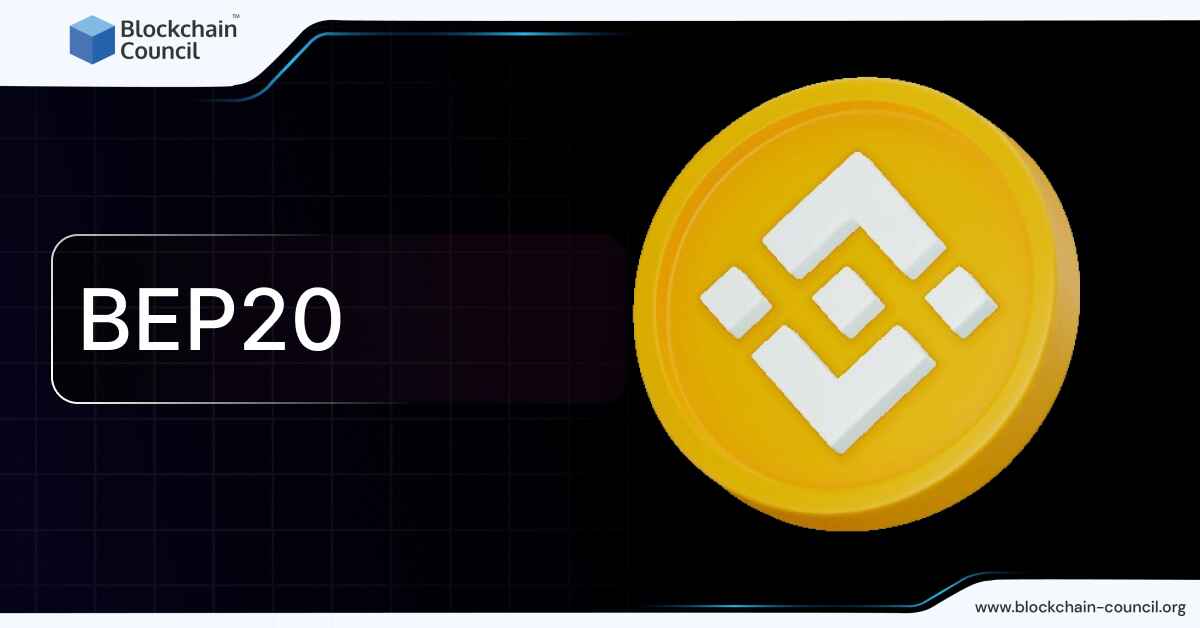
- Blockchain Council
- August 22, 2024
One of the most significant developments in the Blockchain and cryptocurrency space is the BEP-20 token standard. It mirrors Ethereum’s ERC20 to offer an adaptable framework for developers.
But what is BEP20 and is it worth the hype?
Read till the end to find out!
What Is BEP-20?
BEP-20 is a technical standard used for creating and launching tokens on the Binance Smart Chain. Much like Ethereum’s ERC-20 standard, BEP-20 outlines a set of rules that all tokens on the BSC must follow. This includes how tokens can be transferred, who can spend them, and other essential features like minting and burning tokens.
The Binance Smart Chain itself was launched in 2020 as a parallel chain to Binance Chain. While Binance Chain focused on fast and low-cost transactions without smart contract functionality, Binance Smart Chain added this crucial feature and enabled the development of complex decentralized finance (DeFi) projects and other applications.
One of the reasons BEP-20 has gained traction is its flexibility and compatibility. It extends the ERC-20 standard, which means that tokens created under BEP-20 can be easily integrated into existing projects and applications built on Ethereum. Moreover, BEP-20 tokens can also be pegged to BEP-2 tokens (the standard used on Binance Chain) and ERC-20 tokens further enhancing their interoperability within the broader crypto ecosystem.
How BEP-20 Tokens Work
As mentioned earlier, BEP-20 tokens are digital assets that operate on the BSC. It includes a set of rules that tokens must follow, which ensures that they can operate smoothly within the BSC environment. These rules dictate how tokens can be transferred, who can transfer them, and other essential features. These tokens can represent anything from digital currency to utility tokens within a decentralized application.
Key Features of BEP-20 Tokens
- Smart Contract Compatibility: Supports smart contracts for automated, secure transactions, crucial for DeFi, NFTs, and Blockchain projects.
- Interoperability with ERC-20: Highly compatible with Ethereum’s ERC-20 tokens, enabling seamless interaction with Ethereum network, wallets, and decentralized exchanges.
- Cost Efficiency: Lower transaction fees compared to ERC-20, sometimes as low as $0.08 per transaction.
- Speed: Fast transaction confirmation with block times around three seconds, enhancing the user experience, especially in high-frequency trading.
- Minting and Burning: Allows dynamic token supply management through minting (creating new tokens) and burning (reducing token supply).
- Token Management Functions: Includes functions like transfer, balanceOf, and approve for token movement, balance checking, and setting withdrawal limits.
- Pegged Tokens: Supports pegged tokens (Peggy coins) at a 1:1 ratio with other cryptocurrencies, combining BSC’s low fees with assets from other blockchains like Ethereum.
How to Create BEP-20 Tokens?
- Deploy Smart Contract: Use Binance Smart Chain (BSC) to define token attributes like name, symbol, supply, and functionalities.
- Solidity Knowledge: Some familiarity with Solidity is needed.
- Simplified Tools: Use Remix and OpenZeppelin for templates and development help.
- Manage Tokens: Use Trust Wallet or MetaMask to interact, stake, or trade tokens.
- Peg Assets: Create tokens on BSC that mirror assets from other blockchains like Ethereum.
Comparison with Other Token Standards
To fully appreciate BEP-20, it’s helpful to compare it with other token standards like ERC-20 and BEP-2:
ERC-20 vs. BEP-20:
- Adoption: ERC-20 is widely adopted and supports many DApps.
- Fees: ERC-20 often has high gas fees.
- Speed: ERC-20 has slower transaction times.
- BEP-20 Advantage: BEP-20 offers lower costs and faster transactions while maintaining compatibility with the Ethereum ecosystem.
BEP-2 vs. BEP-20:
- Functionality: BEP-2 focuses on fast, non-smart contract transactions.
- Flexibility: BEP-2 lacks support for decentralized applications and cross-chain functionality.
- BEP-20 Advantage: BEP-20 supports smart contracts to enhance the Binance ecosystem’s ability to compete with Ethereum.
Use Cases and Examples of BEP-20
BEP-20 tokens are integral to numerous applications across the BSC ecosystem. These tokens support a broad spectrum of uses, including governance, staking, and as a medium of exchange within decentralized finance (DeFi) platforms. Some of the most prominent BEP-20 tokens include:
- BNB (Binance Coin): The native token of Binance, used for transaction fee discounts, participating in token sales, and as a payment method within and outside the Binance ecosystem.
- CAKE (PancakeSwap): A governance and utility token on PancakeSwap, a leading decentralized exchange on BSC. CAKE is essential for liquidity provision and yield farming.
- USDT (Tether): A stablecoin that mirrors the value of the U.S. dollar, extensively used for trading and DeFi activities due to its stability.
Conclusion
BEP-20 tokens have established themselves as a vital component of the Binance Smart Chain ecosystem. It provides an appealing alternative to Ethereum’s ERC20, particularly for developers seeking lower transaction costs and faster processing times. However, the trade-offs include concerns about centralization and security, which potential users and developers must consider.
To learn more about Blockchain and how you can develop Blockchain projects that help you land a high-paying job, you must get certified with industry favorite certifications like the Certified Blockchain Expert™ and Certified Blockchain Developer™.





































































 Guides
Guides News
News Blockchain
Blockchain Cryptocurrency
& Digital Assets
Cryptocurrency
& Digital Assets Web3
Web3 Metaverse & NFTs
Metaverse & NFTs
